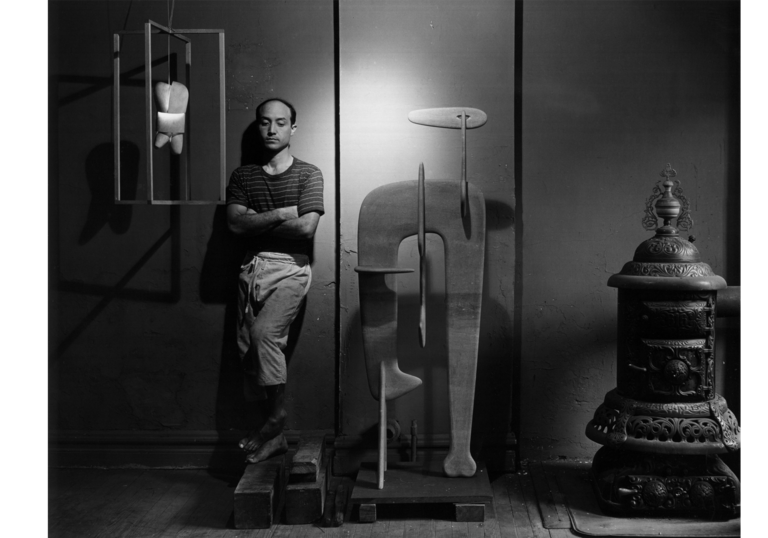Press room
Noguchi

‘Sculpture can be a vital force in our everyday life if projected into communal usefulness.’
Isamu Noguchi
Japanese American sculptor Isamu Noguchi (1904 – 1988) is one of the most experimental and important artists of the 20th century. Barbican Art Gallery is pleased to stage the first European touring retrospective of his work in 20 years. This exhibition is jointly organised and curated by Barbican Centre (London), Museum Ludwig (Cologne) and Zentrum Paul Klee (Bern), in partnership with LaM - Lille Métropole Musée d'art moderne, d'art contemporain et d'art brut.
Retracing the evolution of Noguchi’s kaleidoscopic career over six decades across sculpture, architecture, dance and design, the exhibition celebrates the artist’s inventive and risk-taking approach to sculpture as a living environment. Drawing from The Isamu Noguchi Foundation and Garden Museum in New York, as well as private and public collections, the exhibition brings together over 150 works, including an extraordinary range of sculptures – created in stone, bronze, ceramics, wood, aluminium and galvanised steel – as well as theatre set designs, architectural and playground models, lighting and furniture design. Noguchi opens at Barbican Art Gallery on 30 September 2021.
Mostly known as an icon of mid-century design for his celebrated coffee table and Akari lights, Noguchi pushed the boundaries of sculpture by embracing social, environmental and spiritual consciousness. This major survey celebrates Noguchi as a global citizen travelling across the world to China, Mexico and India, amongst other countries. Rarely exhibited archive materials and photographs also offer illuminating insights into the life of Noguchi, son of a Japanese father and American mother, highlighting the humanist values of this visionary artist.
Jane Alison, Head of Visual Arts, Barbican, said: “We are thrilled to be staging this major retrospective of Isamu Noguchi’s work. I am immensely grateful to The Isamu Noguchi Foundation and Garden Museum in New York, for their generosity and expertise, as well as our partners at Museum Ludwig in Cologne, Zentrum Paul Klee in Bern and LaM museum in Lille where the show will travel after London. Noguchi constantly pushed the boundaries of art, experimenting with materials, scale and place to create art with a purpose. He saw sculpture as a means of creating harmony between humans, industry and nature, as a way to improve how we live, as invention, as play, as art. For fans of Noguchi or those yet to discover his work, I am sure this will be a joy and a revelation.’
Exploring all aspects of Noguchi’s prolific artistic practice, the exhibition presents an extensive range of his vast interdisciplinary output, from his early apprenticeship with modern master Constantin Brâncuși in Paris and celebrated Chinese brush painter Qi Baishi in Beijing, to his public and political art projects of the 1930s, and radical dance collaborations with pioneering modern choreographers Ruth Page and Martha Graham. The exhibition delves into his celebrated interlocking sculptures produced during the 1940s. They comprise multiple parts to be assembled and dissembled, displaying Noguchi’s outstanding creativity in the face of adversity during the Second World War.
Organised by interconnecting themes as well as chronological artistic development, the exhibition highlights Noguchi’s close and enduring friendship with inventor and futurist R. Buckminster Fuller. Their creative dialogue on the cosmic scale of the universe inspired Noguchi’s world consciousness and continued use of new technology from his artistic beginnings until his late career. The self-illuminating Lunar sculptures were created after his devastating experience of voluntary internment at a camp for Japanese Americans in Poston, Arizona in 1942. These experiments went on to influence some of his best-known works, the Akari light sculptures. Using washi paper and electric bulbs, Akari combine traditional and modern technology, while bringing sculpture to everyday households, in line with the artist’s democratic commitment to accessible public art.
The exhibition also includes an outstanding selection of his ceramics made in post-war Japan demonstrating Noguchi’s innovative approach to traditional craft techniques – he was one of the first sculptors to incorporate these within contemporary practice. His environmental designs produced in response to the atomic bombing of Hiroshima address themes of violence and peace, while conveying the Los Angeles-born artist’s negotiation of his own biracial identity. Photographs from his travels through Europe and Asia between 1949-50 reveal Noguchi’s exploration of artistic hybridity and expansion of sculptural media into large-scale architectural environments, including his fascination with the Jantar Mantar astronomical observatories in India, reiterating his combined interest in modernism and past civilisations. The exhibition culminates with iconic large-scale works from the 1960s, 1970s and 1980s, when he practised between studios in the USA, Italy and Japan, and finally realised his public designs for monuments, gardens and playgrounds.
Noguchi
Barbican Art Gallery, London, UK
30 September 2021 - 23 January 2022
Media View: Wednesday 29 September 2021, 10am-1pm
Ann Berni, Senior Communications Manager: 020 8609 8762, [email protected]
Anna Dabrowski, Senior Communications Manager: [email protected], 07921 219144
Daisy Robinson-Smyth, Communications Assistant: 020 7382 7254, [email protected]
